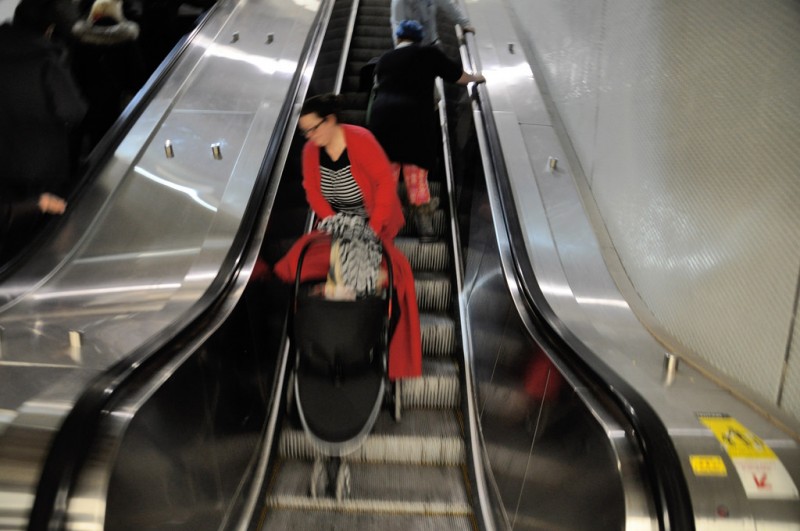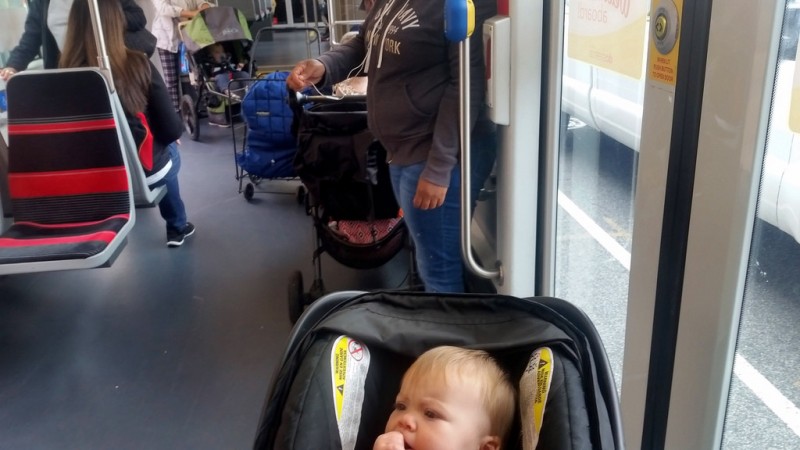10 things I learned carting a stroller on transit for two years

Image by the author.
I became a father in 2016. Shortly thereafter, thanks to the magic of a baby stroller, I began to navigate and experience transit differently. Here are 10 things I learned from that experience, beginning with three about the wheel-user’s best friend and greatest enemy: Elevators.
1. Be prepared to miss a lot of trains
It’s wonderful that 100% of WMATA Metro stations are elevator accessible. And most of the time the elevators do work. Compared to many cities elsewhere in the country, and even many abroad, Metro is gloriously accessible.
That doesn’t mean it’s simple, easy, or fast. Entering the Metro usually requires at least two elevator rides: One from the street to the mezzanine, and a second from the mezzanine to the platform.
Except for a couple of stations with impressively high-speed elevators like Rosslyn and Forest Glen, most of the elevators are slow. Many a time did I watch forlornly out the window of a slowly descending platform elevator as a train pulled away that I easily could have caught had I used the escalator.
Two elevators is generally the minimum. Some stations take more. To get from Hopscotch Bridge to Union Station Metro requires, for example, four separate elevators, each descending only a single level: One from Union Station’s parking garage to Union Station’s retail mezzanine, a second from the retail mezzanine to the building’s ground floor, a third from there to the Metro station mezzanine, and finally a fourth from the Metro mezzanine to the platforms.
It takes a long time. And that’s if there’s no lines.
2. Every elevator has a unique quirk that you have to learn
Seemingly all of Metro’s elevators have a quirk, and the same quirk rarely repeats. This one takes a full minute to close its doors so just wait it out, but that one starts closing before a single person can exit so rush forward and stick your foot in right away or you’ll miss it. This one only works if you press the button twice, and on that one be sure to follow the instructions hand-painted by a WMATA employee using White Out. Etceteras etceteras ad nauseam.
Too many riders were hitting the emergency call button, so Metro improvised. Image by the author.
3. A lot of people use elevators even if they don’t need to
Not all disabilities are visible. It’s not always possible to tell who needs an elevator and who doesn’t. Nonetheless, it’s abundantly clear that a large portion of elevator users don’t really need to use the elevator. They’re doing so because it exits closer to their destination on the sidewalk, or because it was right in front of them as they got off the train, or sometimes because they thought it would be a nice place to pee. Whatever the reason, elevators are often packed with healthy-looking people walking.
There’s nothing really wrong with that, but it does sometimes force those who do need the elevator to wait longer than they already have to. And while missing a train because elevators are just slow is slightly annoying, missing one because you had to wait for the elevator to cart three loads of healthy walkers up and down before you got a turn is exasperating.
I’m privileged enough that if I’m carting a stroller and there’s a line to use the elevator, I can feel confident with a non-apologetic “excuse me.” But many parents are more shy.
4. SorryNotSorry for using the escalator if I have to, though
Metro does not want you to use the escalator with a stroller. It’s a liability, and they don’t want to be sued if you lose your grip on your stroller. But when you get off the train after an hour-long trip, and you find the elevator out of service, crouching around and holding the stroller on its rear wheels to ride up an escalator is a better option than going to a different station or asking (and then waiting) for a shuttle.
And yes, helpful person rushing down the escalator who has to step to the side to get around my one-year-old, I am actually aware there’s an elevator. You must not have noticed it’s out of service, but I did. Have a super day!
5. The only practical way to ride Metrobus is if the driver breaks the rules
Metrobus has a blanket stroller policy: To ride a Metrobus, children must come out of the stroller, and the stroller must be folded up. No exceptions, though there’s a petition to change this.
This is a workable if uncomfortable way to ride the bus with a baby, provided you are not trying to carry anything else besides the baby in one hand and the stroller in the other. Sadly, 100% of trips involving a baby also involve at least one bag, and trying to hold on to a baby, a folded stroller, and a diaper bag (plus whatever else you might be carrying) all at the same time as a single adult is not practical. Certainly it’s a terrible choice if you have other options available to you, like driving or hailing a car.
One can see how this policy might make sense on crowded buses, since a stroller might block the aisle and prevent other riders from using the bus. But at off-peak times when there’s plenty of room on the bus, and aisles open enough to walk around a parked stroller, having a bus driver insist you break down the stroller is like having a bus driver tell you to stay off the bus next time.
And no, juggling a squirming baby in my arms while the bus bumps around is not remotely safer than having them belted into a wheel-locked stroller.
Did I mention that my Metrobus ridership plummeted for two years? Quelle coïncidence!
6. DC Circulator applies common sense
DC Circulator’s stroller policy is a 180 degree object lesson in good common sense:
“When space permits, children may remain in a stroller. Keep strollers out of the aisle and lock the wheels. Hold on to your stroller at all times.”
If it’s crowded, the driver may ask you to fold up your stroller. Otherwise, just try not to be a jerk.
Thumbs up, DC Circulator.
7. The streetcar is amazing for strollers
Unexpected benefit of the streetcar: It’s the most stroller-friendly transit in the city.
Everything is level with the sidewalk. Streetcar doors open up directly onto the sidewalk, and you glide right in to an open interior with tons of space. No elevators, no steps, no narrow aisles, no obtusely inflexible rules. It’s a dream.
When I had my stroller, I routinely walked 20 minutes out of my way to take the streetcar instead of a bus. It was so much easier.
And word is out. If you ride the streetcar around 9:30 am—after the morning rush has ended, when parents and other care-givers start to come out to run errands—you might count more strollers than single adults. My morning trips usually averaged five or six other strollers on the streetcar with me, but I’ve counted as many as 10 on a single streetcar ride.
Parents know: The best stroller transit is streetcar. Image by the author.
8. Umbrella strollers fit through fare gates, big strollers don’t
Look, it’s convenient to haul around a gigantic stroller. If you’re carrying around a kid then you’re also probably carrying around a lot of other stuff. Packing it all onto a stroller is easier and more comfortable than carrying it on your back or slung over your shoulder.
Unless you hope to go through fare gates, in which case most SUV-esque strollers don’t fit. They will fit through the handicap fare gates, but those are slow and often have lines. If you want to get through quickly, make the trade-off to a smaller umbrella stroller.
9. Metrorail end doors are your friend
Nobody wants to be a jerk with their stroller. You want to get it out of the way of other riders. The best place on any Metro train for that is the very end of the car, where stashing the stroller in the aisle blocks the fewest people. These seats also tend to be less crowded than the handicap seats by the center door.
Plus, when your kid is old enough to get out of the stroller, these relatively private seats also reduce your guilt at the occasional toddler scream.
The best seats on any Metro car, if you've got a stroller. Image by Michael Sauers licensed under Creative Commons.
10. Most people are a joy to children
This post is pretty complainy. And the truth is, having a kid is just hard sometimes. Besides correcting an occasional dumb policy, and maybe keeping more elevators open more often, there’s only so much any transit agency can do to streamline the difficulties of travel with a young child.
But one thing that makes it easier is the other riders. When you walk onto a train with a baby (especially a very young baby), eyes light up and smiles appear. Strangers look up from their phones and give your kid a funny face. People say hello, and they hold doors, and they help you lift your stroller, and more often than not they get out of your way.
People are friendly. And understanding. I’ve had scores of wonderful interactions with affectionate strangers thanks to my child. And never once a nasty comment about noise or cheerios, even when there was plenty of noise and cheerios.
So thanks, everyone. And sorry if I was a jerk about the elevator.
